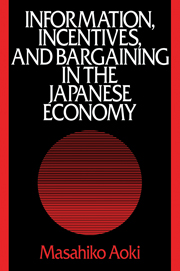 Information, Incentives and Bargaining in the Japanese Economy
Information, Incentives and Bargaining in the Japanese Economy Book contents
- Frontmatter
- Contents
- List of figures
- List of tables
- Preface
- 1 Introduction
- 2 The information structure of the J-firm
- 3 The ranking hierarchy of the J-firm as incentive scheme
- 4 Corporate finance, stockholding returns, and corporate governance structure
- 5 Bargaining game at the J-firm
- 6 The changing nature of industrial organization
- 7 Bureaupluralism
- 8 Culture and economic rationality
- Author index
- Subject index
5 - Bargaining game at the J-firm
Published online by Cambridge University Press: 14 January 2010
- Frontmatter
- Contents
- List of figures
- List of tables
- Preface
- 1 Introduction
- 2 The information structure of the J-firm
- 3 The ranking hierarchy of the J-firm as incentive scheme
- 4 Corporate finance, stockholding returns, and corporate governance structure
- 5 Bargaining game at the J-firm
- 6 The changing nature of industrial organization
- 7 Bureaupluralism
- 8 Culture and economic rationality
- Author index
- Subject index
Summary
So far I have treated the human resources and the financial resources of the J-firm separately. I have also emphasized the competitive aspect of individual incentives and the possible conflict of interests between different types of stockholders. In this chapter, I deal with the collective interests of quasi-permanent employees and stockholders and analyze the way they interact at the J-firm with the mediation of management. It is assumed that various interests of quasi-permanent employees are aggregated and represented by the enterprise-based union. The possible deviation from share price maximization on behalf of the bank stockholder may be regarded as the agency fee that individual stockholders pay the bank for its monitoring function, although I do not deal with this cost explicitly here. I assume that the body of stockholders is interested in share price maximization.
These two bodies are considered to be integral elements of the J-firm. The efficiency of the decentralized micro-micro information structure of the J-firm as discussed in Chapter 2 depends on the information-processing capabilities of the quasi-permanent employees who participate in it; and information that is generated, processed, and developed within the structure is accumulated and shared among them. They even contribute to a nonnegligible portion of the capital of the J-firm in the form of the accumulated claims for separation payment and future seniority premiums. On the other hand, the body of stockholders contributes an increasing amount of equity capital to the J-firm that is transformed into physical assets that are not readily malleable.
- Type
- Chapter
- Information
- Information, Incentives and Bargaining in the Japanese EconomyA Microtheory of the Japanese Economy, pp. 150 - 203Publisher: Cambridge University PressPrint publication year: 1988


